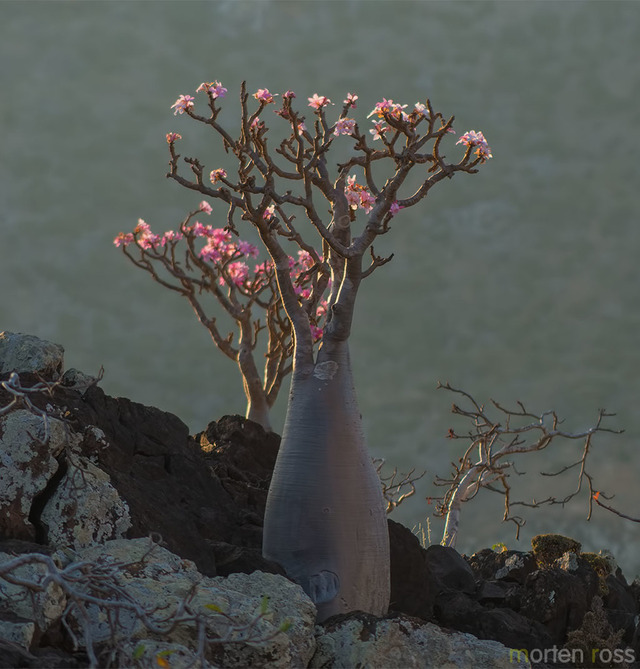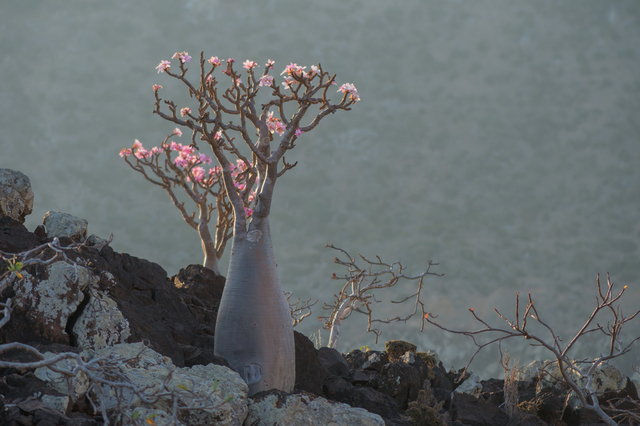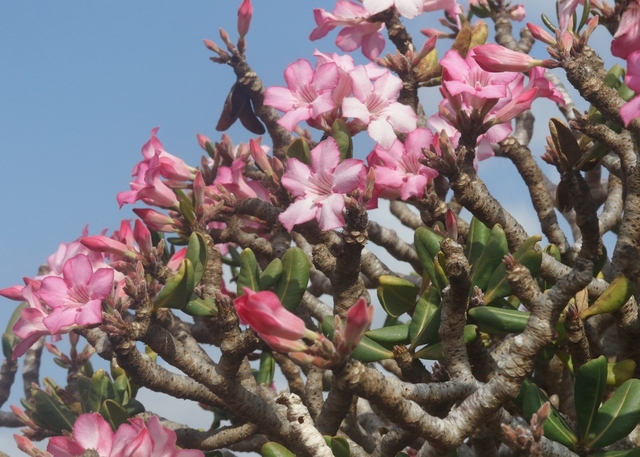Desert Rose (Adenium obesum) is a stunning succulent plant known for its thick, swollen base, vibrant trumpet-shaped flowers, and remarkable drought tolerance. Native to Africa and the Arabian Peninsula, this hardy ornamental plant thrives in arid and semi-arid climates, making it a favorite among gardeners and bonsai enthusiasts worldwide.
Also referred to as Tianbao flower, rich flower, sand red flower, Adam flower, and dwarf plumeria, Desert Rose is admired for its striking appearance, slow growth, and ability to thrive in poor soil conditions. Whether grown as a bonsai, a landscape plant, or a potted indoor plant, Adenium obesum remains a symbol of resilience and beauty.
Here is the scientific classification of Desert Rose (Adenium obesum):
Kingdom: Plantae
Clade: Tracheophytes
Clade: Angiosperms
Clade: Eudicots
Order: Gentianales
Family: Apocynaceae
Subfamily: Apocynoideae
Tribe: Nerieae
Genus: Adenium
Species: Adenium obesum
This classification places Adenium obesum within the Apocynaceae family, which also includes oleander (Nerium) and plumeria (frangipani). The plant is well-known for its succulent nature, drought tolerance, and ornamental value.

Desert Rose is a small, succulent shrub or tree that can grow up to 2–3 meters (6–10 feet) in height in its natural habitat. However, when cultivated in containers, it usually remains compact, making it a popular choice for bonsai and indoor plant collections.
The leaves of Adenium obesum are thick, glossy, and arranged in clusters at the ends of branches. Depending on the variety and environmental conditions, the leaves can be dark green to bluish-green and may drop during dormancy in cooler temperatures.
One of the most attractive features of Desert Rose is its brilliantly colored flowers, which range from pink, red, and white to multicolored hybrid varieties. The flowers resemble plumeria (frangipani) blooms and appear in clusters, creating a visually stunning display. Desert Rose typically flowers in late spring to summer, although with proper care, it can bloom multiple times a year.
A distinguishing characteristic of Desert Rose is its thick, swollen base (caudex), which serves as a water reservoir, allowing the plant to withstand prolonged dry conditions. The unique caudex shape makes it a prized specimen for bonsai cultivation.

Desert Rose thrives in full sunlight, requiring at least 6–8 hours of direct sunlight per day for optimal growth and flowering. Indoors, place the plant near a south-facing window or use grow lights to ensure adequate light exposure.
Well-draining soil is crucial for Desert Rose. The ideal soil mix should be:
Sandy or gritty to enhance aeration
Well-draining to prevent root rot
Rich in organic matter for optimal growth
A cactus or succulent mix with added perlite, pumice, or sand works best.
Despite its succulent nature, Desert Rose requires moderate watering:
During active growth (spring and summer): Water deeply when the top 1–2 inches of soil feels dry.
During dormancy (fall and winter): Reduce watering to once every 2–3 weeks, preventing root rot.
Overwatering is the leading cause of root rot, so it’s essential to allow the soil to dry between waterings.
Desert Rose thrives in warm temperatures between 70–95°F (21–35°C). It is not frost-tolerant and should be protected when temperatures drop below 50°F (10°C). For those in cooler climates, growing Desert Rose in containers allows for easy indoor overwintering.
To encourage vigorous growth and abundant blooms, feed your Desert Rose with a balanced, slow-release fertilizer (10-10-10 or 12-12-12) every 4–6 weeks during the growing season. A high-phosphorus fertilizer (5-10-10) promotes flowering.
Pruning helps maintain the plant’s shape and encourages branching. Trim leggy or weak stems in early spring before new growth appears. Always use sterilized pruning shears to prevent infections.

Growing Desert Rose from seeds is an excellent way to develop a well-shaped caudex. Fresh seeds have the highest germination rate.
Sow seeds in a well-draining succulent mix
Keep soil moist but not soggy
Provide warm temperatures (75–85°F or 24–29°C) and bright light
Germination usually occurs within 7–14 days.
Stem cuttings can be used to propagate Desert Rose, though they develop a less pronounced caudex than seed-grown plants.
Allow cuttings to dry for 24–48 hours
Dip in rooting hormone to enhance root development
Plant in a well-draining soil mix and water sparingly
Grafting is commonly used to create hybrid varieties with unique flower colors. This method involves attaching a cutting from a desirable variety onto a mature rootstock.
Desert Rose is susceptible to:
Spider mites – Identified by fine webbing and yellowing leaves
Mealybugs – White, cotton-like insects on stems and leaves
Aphids – Small insects feeding on young growth
Use insecticidal soap, neem oil, or natural predators (like ladybugs) to control infestations.
Root rot – Caused by overwatering; prevent by using well-draining soil
Fungal infections – Appears as black or brown spots on leaves; treat with fungicide
Desert Rose is toxic to humans and pets due to its milky sap containing cardiac glycosides. Ingesting any part of the plant can cause nausea, vomiting, and irregular heartbeats. Always handle with care, wear gloves when pruning, and keep it out of reach of children and animals.
Unique Aesthetic – Its swollen caudex and vibrant flowers make it a stunning ornamental plant.
Low Maintenance – Drought-tolerant and pest-resistant, making it perfect for busy gardeners.
Bonsai Potential – Can be trained into miniature bonsai forms, enhancing its artistic appeal.
Indoor & Outdoor Versatility – Thrives in containers, allowing it to be grown in various climates.
Desert Rose (Adenium obesum) is a striking, easy-to-care-for succulent that brings a touch of exotic beauty to any garden, patio, or indoor space. With proper sunlight, well-draining soil, and careful watering, this resilient plant can thrive for years, rewarding growers with its spectacular blooms and sculptural growth.
Whether you're a seasoned succulent collector or a beginner looking for a low-maintenance yet visually stunning plant, Desert Rose is an excellent choice.
animal tags: Apocynaceae
We created this article in conjunction with AI technology, then made sure it was fact-checked and edited by a Animals Top editor.